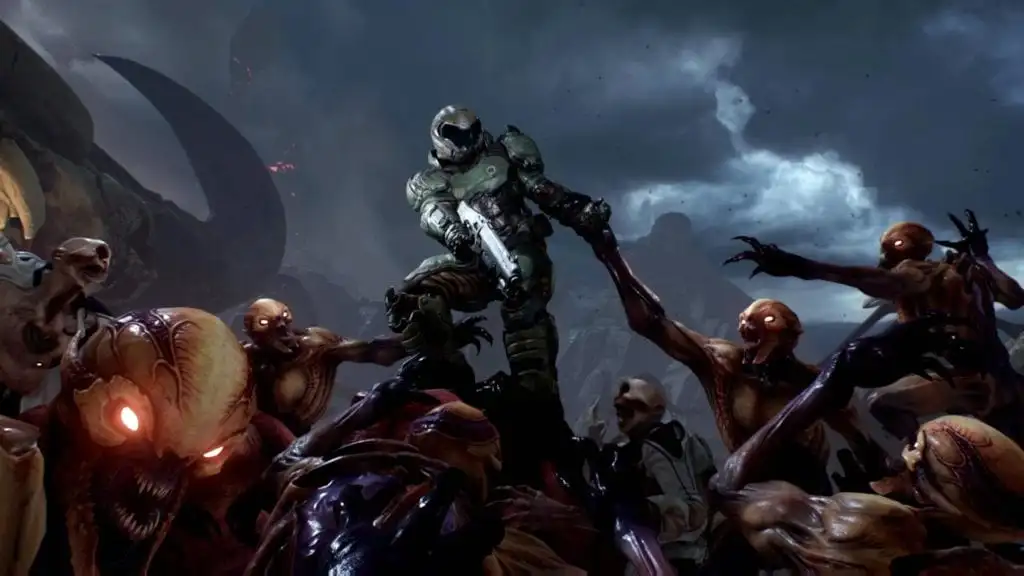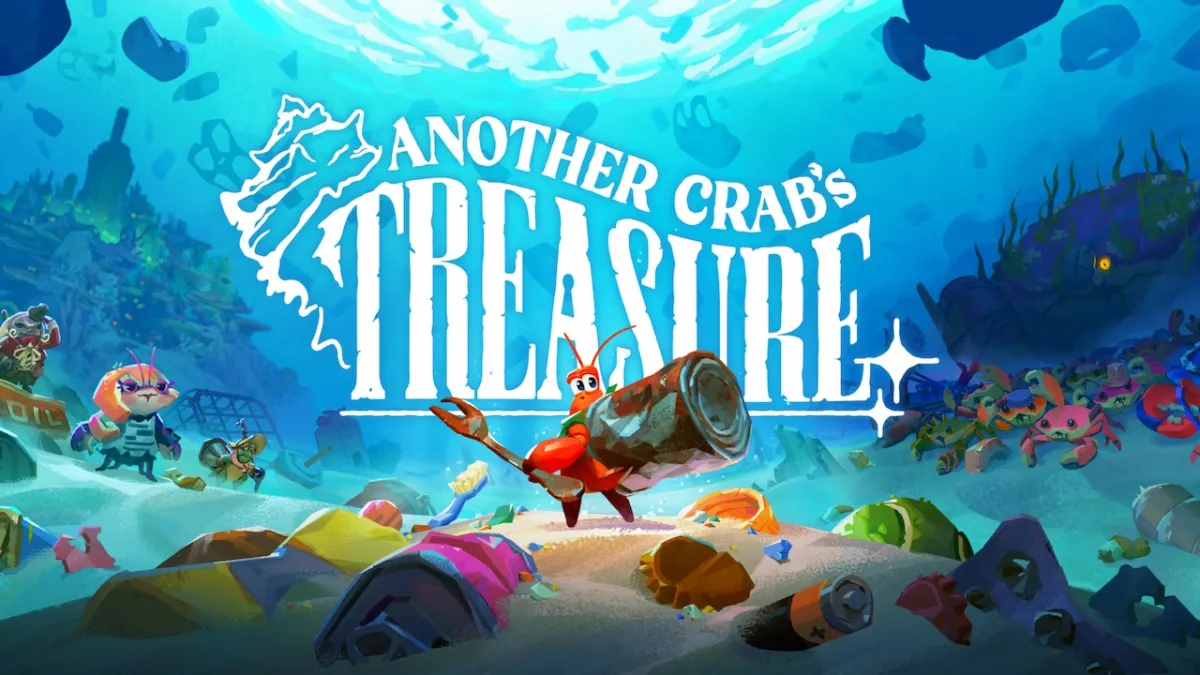There’s a big problem with making a game and calling it Doom, and that problem is that you’re never, ever going to live up to its predecessor.
That’s not me being a dick about the skill of the team working on Doom 2016 (or Doom 4: DOOM, or whatever you want to call it). It’s just that Doom – the classic Doom, released back when my age was a single digit number – was a perfect storm of game design.
It came at a time when a small team could actually develop a triple-A title. It was a time when one single person could create an entire level by themselves and infuse their personality throughout it. It’s a game which should be studied carefully by anyone with an interest in level design or game design, and no matter how good your team is, there’s simply no way you can recreate those conditions in 2016. Whether or not you think Doom has aged well as a “fun” game, it’s a piece of near-flawless design and something that’s absolutely worthy of the awe in which it’s held.
Which means that Doom 2016 already has its work cut out for it, because it’s living in the shadow of its (literally) game-changing grandfather.
Still, if we pretend its grandfather doesn’t exist – which is probably what the game itself is trying to do, considering it’s called Doom rather than Doom 4 – then what’s on offer is actually pretty damn accomplished.
The new Doom is split into three parts, all of which deserve a fair amount of attention. Somewhat inevitably, first up is the campaign.
Doom‘s campaign is not Doom 3‘s campaign: it’s fast, brutal, and expansive. It’s a lot closer to something like Serious Sam or Shadow Warrior than its own predecessors, with plenty of extended battles against spawning demons in carefully designed arenas with some mostly-linear wandering between these segments, but that’s no bad thing. This means big areas full of bounce pads and power-ups, double-jumping for aerial control, and a hell of a lot of high-powered weaponry.

If you’re not looking at this and thinking of all the possibilities with strafing and double-jumping and so on, I’m not sure we can be friends.
The campaign emphasises motion over anything else. When dropped to a certain level of health, enemies are “staggered”, at which point they can be finished with a spectacularly gory Glory Kill. Killing them in this way causes them to drop health… and since you don’t have health regeneration, this means that your best option in combat is usually to run towards enemies. Dodge attacks, circle-strafe, open fire, and then close in for the kill just to stay alive. It’s a wonderfully clever piece of design that forces you to remain actively mobile in combat, and not just because some enemies attack you in melee.
Levels also reward exploration, packed as they are with secrets and various doodads that let you increase your power. Each weapon has two alternate fire modes, unlocked by finding upgrade drones, and then further upgraded with weapon skill points. Your basic stats – max health, max armour, and max ammo – can be upgraded with another collectible. And the Doomguy armour itself, the Praetor Suit, also has a variety of upgrades.

If you’re working for a tech company who have demonic altars and hold ritual sacrifices, you might want to think about finding another job.
This… actually kind of works against the game, at times. It’s simply an issue of pacing: Doom has a very kinetic feel and relies a lot on constant forward movement, both in combat (as noted above) and in exploration, where you double-jump and mantle your way around the environment. Constantly stopping to check your automap and investigate the area for secrets slows the pace considerably. On the one hand, it’s nice to have little lows in between the frenetic highs of battle; on the other hand, it breaks the flow quite inelegantly.
I’m also not entirely convinced by the enemy tuning, with some able to take so much punishment that your weapons – even the rapid-firing rocket launcher and the almighty Super Shotgun – can feel a little underpowered. Minor thing, though one that’s highlighted a lot when you unlock “classic” levels from Doom and Doom 2 (the same levels, but with the new enemies and weapons) and discover that Doom 2016‘s enemies are way more resistant to gunfire than the old ones ever were. It’s mostly a matter of taste and changing design in games, I suppose.
Nonetheless, the campaign itself is an enjoyable eight-hour romp (give or take a couple of hours depending on the difficulty level and your propensity for finding secrets) that doesn’t take itself particularly seriously. The protagonist’s love of solving every problem with explosions frustrates most other characters when they’re trying to give exposition; indeed, at one point you’re asked to carefully remove some delicate equipment so it can be reinstalled later, and the response is… to smash it to bits. Whether or not this is the protagonist making a statement, or simply not giving a shit and wanting to kill more stuff, is left open to interpretation.
Level design is pretty decent across the board, although it’s the Hell levels that really feel like Doom. What with not needing to look like an actual facility used by humans, these allow for all sorts of alien architecture, deadly traps, and weird layouts. (Oh, and the game does actually learn colours other than brown exist, and later enemies are far more recognisable than the early ones – although even when it’s not being brown, it does tend towards being either blue or orange in the traditional media contrast.)
I’d suggest playing it on a higher difficulty, though. Maybe don’t use console commands to unlock Nightmare from the start, as that’s rather aptly named in terms of difficulty and I think it skips the opening sequence, but if you’re at all proficient with shooters then Hurt Me Plenty is a bit too easy for most of the game.
Next on the list of the Three Things is the multiplayer, which I can’t say too much about because my internet connection has been violently fucked pretty much since Doom came out.
I think my opinion remains pretty much what it was back when I played the beta: it’s fast and frantic, albeit not as fast as the single-player. There are now more maps, more game modes, more weapons, and more demons to play as, but it’s still got the Call of Duty-style playlists and no server browser. I’m still not exactly keen on the demons themselves – they’re ludicrously powerful and break up the otherwise joyous movement-based shooting – but time might reveal them to be a bit weaker than they currently seem. Or maybe we’ll get a No Demon playlist.
In any case, I mostly like it, though I have a feeling it’s not going to keep people playing for too long. I mean, I’m enjoying it for now, but if you didn’t like the beta then this is hardly going to convince you and I’m not convinced I’ll be itching for a spot of multiplayer Doom in a week or so. In the short term, at least, I’m enjoying playing a multiplayer shooter that doesn’t rely on instant headshots or cowering behind cover.
The third part of Doom‘s demonic trifecta is the level-creating SnapMap, which is really weird and probably deserves an article all to itself.
In basic terms, SnapMap seems like it’s trying to make level creation as easy (or, hell, even easier than) making levels for the original Doom, because level creation has moved further and further into “time-consuming and annoying” territory since those days. Obviously, some of that is because we now have a third-dimension and actual 3D to deal with. So how do you make it easy?
The answer, apparently, is to create pre-fabricated rooms and then let players “snap” them together to form a map. From there, the actual logic of how the map works can be assembled through triggers, with all sorts of special effects and monster placements and AI and all sorts available.

SnapMap offers up a variety of views, letting you see your level from all sorts of angles, including from within the level itself. You can also quickly fire up the level to “test” whatever you’ve just done.
SnapMap is, simultaneously, a wonderfully powerful and a staggeringly limited creation tool. It’s also very, very easy to use, but rather tricky to master, to the extent that I’m not quite sure just how powerful it is.
On the easier end of the scale, you can slap a bunch of rooms together, set up an AI director to spawn enemy encounters that gradually get more difficult as the level goes on, set up another one to randomly spawn items, and play your level. On the more difficult end of the scale, people appear to have already made tower defence games and memory tests.
For my part, I tried making a linear, Doom-like level with traps and spookiness and secret walls, and after about two hours I’d neatly fleshed out the first few rooms. You started in an elevator and proceeded out into a dark corridor, where you could hear nearby Pinky demons (which were tucked away in a nearby secret room). Proceeding down the hallway would trigger explosions as enemies appeared. Continuing onwards, you’d head through the next few rooms and eventually pass an invisible trigger that would open the secret room containing the aforementioned demons that would suddenly attack from behind… etc.
And yet I’m not quite sure how powerful it really is. I mean, clearly, there are ways to use the logic to do really in-depth things, but I’m not sure how roundabout those are. Nonetheless, despite the limitations inherent in the set “room” designs and the like, there’s an awful lot of scope here for everyone from beginners to experts to play around and make some weird and wonderful stuff.

The basic templates let you create all sorts of game modes, ranging from multiplayer maps to straight-up survival modes, although the lack of a server browser sorta hurts the possibility of the community discovering amazing multiplayer maps.
It’s even got a decent set of tutorials and learning tools. The best of the lot are the “puzzles”, which play out like some sort of cross between Portal and The Incredible Machine. Given a limited set of the SnapMap tools (with some others set up, which you can’t fiddle with) you need to find a way to make the level completable. This might range from setting up a score counter on demons so that a door locked by a score threshold will open when they die, to binding the Use Equipment key to teleport you next to an item you need when you press it, and teleporting you next to the exit when you release it. And those are some of the easier ones, which should give you an idea of what it allows.
The PC interface for SnapMap isn’t exactly wonderful, but it’s also not something I had much trouble with. It’s clearly been designed so that it’d also work on consoles, but the plethora of hotkeys mean it’s not a particularly unpleasant experience. I mean, it’s considerably better than Fallout 4‘s construction interface, so that’s something. Right?
All of this combines to make a surprisingly large package. There’s a decent, explosive, shoot-y campaign. There’s a multiplayer segment which you might enjoy, or you might tire of quickly, or you might deride for trying to hew a little too closely to other shooters instead of being a full-on Doom/Quake experience. And there’s SnapMap, which allows for an awful lot of possibility for the future.
With all of that in mind – and considering how well-optimised it seems to be on PC – I have a hard time not recommending Doom. For all the little bits and pieces I don’t like about it (the campaign ending, for instance, is more than a little unsatisfying) there’s always something else, whether it’s fiddling with SnapMap or having another go at the perma-death Ultra Nightmare difficulty.
It might not be as world-breaking as its namesake, but then it never could be. For what it is, Doom is a well-crafted, well-optimised shooter with an awful lot of content.











